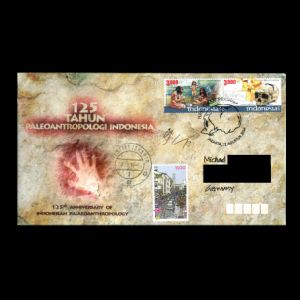Indonesia 2014 ""125 years Paleoanthropological Institute Indonesia"
| <prev | back to index | next> |
| Issue Date | planed on 31.08.2014, issued on 12.09.2014 |
| ID | Michel: 3147-3148; Scott: 2390a-b; Yvert et Tellier: 2708-2709; Stanley Gibbons: 3627-3628; Category: An |
| Design | stamps: Guruh Ramdani; FDC: Tata Sugiarta |
| Stamps in set | 2 |
| Values | 3000 - Homo erectus family 3000 - Homo sapience skull |
| Emission/Type | commemorative |
| Issue places | Jakarta |
| Size (width x height) | 41.06mm X 25.31 mm |
| Layout | Sheet of 30 stamps |
| Products | FDC x1 |
| Paper | Tullis Russel |
| Perforation | 12.75 x 13.50 |
| Print Technique | Offset, 4 colors + 1 invisible ink |
| Printed by | Perum Peruri |
| Quantity | stamps: 300.000 sets; FDC: 4.000 pieces |
| Issuing Authority | Pos Indonesia |

Indonesian Post planned to issue this set of stamps in order to commemorate 125 anniversary Paleoanthropological Institute of Indonesia exactly on the same date as for 25 years, on August 31. However, for some reason, the issue was delayed. These stamps arrived at post office almost two weeks later, on September 12, 2014
Paleoanthropology, the interdisciplinary branch of anthropology concerned with the origins and development of early humans. It is the study of ancient humans as found in fossil hominid evidence such as fossilized bones and footprints.
The following text is based on the text from the brochure included in the FDC with some notes added by the author of the website.
Early human fossils were first discovered by mining engineer B.D. van Rietschoten in 1889 in the village of Wajak, Tulungagung, East lava. This finding was later recognized as the first ancient human fossil findings reported from Indonesia. After that, Eugene Dubois rediscovered ancient human fossils in Wajak village in 1890.
Marie Eugène François Thomas Dubois (28 January 1858 – 16 December 1940), was Dutch paleoanthropologist and geologist. He earned worldwide fame for his discovery of Pithecanthropus erectus (later redesignated Homo erectus), or "Java Man". Although hominid fossils had been found and studied before, Dubois was the first anthropologist to embark upon a purposeful search for them.
From these findings, it was revealed mysteries of ancient human fossils were later named as Homo wajakensis (man of Wajak). Homo wajakensis is classified as a hominid.
Homo wajakensis’ height was about 173 cm and showed characteristics of Mongolia and Australid race who lived 40,000 to 25,000 years ago.
The skull of Homo wajakensis was 1,550 cm3 capacity for the female and 1,650 cm3 for the male. The skull volume exceeds the volume of a modern human skull.
Observing the shape of the skull, Homo wajakensis had a hefty bulge in its forehead like Australid and flat broad face with prominent cheekbones aside as Mongolid. Large eye sockets, but rather low. Its nose bone was small, flat and wide nostrils. Its palate was large and deep, and greater than Australid, had big teeth but in modern proportions. The lower jaw was stocky, strong, and heavy, whereas a weak chin and tilted back. From the femur and tibia bone, it can be concluded that Homo wajakensis was slender and tall.
Homo wajakensis skull had many similarities with the Australian native skull, Aborigines. Therefore, Eugene Dubois suspects that it was included in Australid race. Homo wajakensis fossils also has similarities with the human fossil of Niah in Sarawak, Malaysia, man of Tabon in Palawan, Philippines, and Australid fossils from South China and South Australia.
Other archaeological evidence indicates the existence of a cave dwelling (rock-shelter) which was where the ancient human lived at the time. The findings of food debris, as seashells (Gastropoda) and also animal bones as kitchen waste. The archaeological evidence provides information about Homo wajakensis where these individuals lived. On the left stamp you can see a diorama located in the museum at the Sangiran early man site. The diorama includes three persons of a Homo erectus family found at Sangiran area of Indonesia.
Excavations at Sangiran from 1936 to 1941 led to the discovery of the first hominid fossil at this site. Later, 50 fossils of Meganthropus palaeo and Pithecanthropus erectus/Homo erectus were found. Inhabited for the past one and a half million years, Sangiran is one of the key sites for the understanding of human evolution.
Sangiran Early Man Site is situated about 15 kilometers in the north of Solo town in Central Java, Indonesia, covering an area of 5,600 hectares. There is a very significant geological sequence from the upper Pliocene until the end of Middle Pleistocene by depicting the human, faunal, and cultural evolutions within the last 2.4 million years. The property also yields important archaeological occupation floors dating back to the Lower Pleistocene around 1.2 million years ago.
Ever since von Koenigswald found flake tools in the Ngebung village in 1934, the site has made an immense contribution to the study of evolution over the past million years by illustrating the evolution of Homo erectus.
Homo erectus is important to the study of the early history of mankind before the emergence of the modern Homo sapiens. Fossils of Homo erectus have been found from time to time in a site covering 8 km by 7 km since 1936 to the present day.
Products and associated philatelic items
| FDC (clean and mailed) | First-Day-of-Issue Postmarks | |
 |
 |
 |
| Brochure, attached to the FDC | Stamps-Sheet | Example of circulated covers |
 |
 |
 |

|
References
- Technical details and brief description:
Info Brochure, reverse side of the FDC, Colnect - Sangiran:
Wikipedia UNESCO
Acknowledgements
Many thanks to Dr. Peter Voice from Department of Geological and Environmental Sciences, Western Michigan University, for reviewing the draft page and his valuable comments.| <prev | back to index | next> |